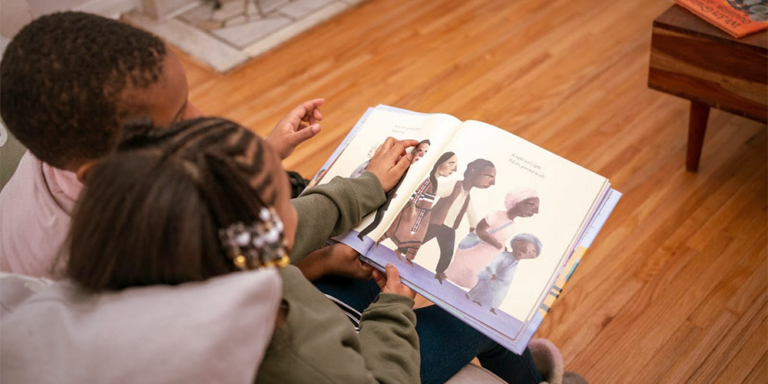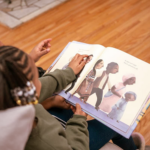Drama Games aren’t only for drama teachers—they can be used by all to break the ice, warm students up, and build connections. You can play a ten-minute game at the start of any lesson to engage your students, or you might like to run a full-length drama workshop as a creative way to get to know your students better. Get started with the three drama games listed at the end of this blog.
How Drama Empowers
One of my main goals as a drama teacher is to help students to trust themselves. Improvisation games are the perfect tool to help students to do this. I’ll call out, “Don’t think, just do.” It’s a simple command that nudges students to follow their intuition. Often, they surprise themselves with what their imaginations are capable of.
During my years of teaching drama, I’ve seen children and young people go from:
- Shy to Confident
- Afraid to Brave
- Blocked to Creative
- Voiceless to Empowered
When taught right, drama is inclusive and empowers. Drama games help students express themselves, allowing them to feel seen and heard. Drama helps with skills like awareness, confidence, concentration, creativity, critical thinking, diction, empathy, listening, literacy, problem-solving, social skills, storytelling, and teamwork—but drama is only empowering if a safe space is created.
Foundations for Creating a Safe Space
It’s the facilitator’s job to make the class accessible to all and creating a safe space is a crucial part of this. Do not underestimate how important a safe space will be for some of your more vulnerable students. My number-one rule is to never put a student on the spot or force them into an activity, game, or performance. Encouragement is valuable, but it must be applied thoughtfully. In drama, there’s a potential to inadvertently stir up past traumas for students who have undergone such experiences.
Here are some more tips for creating a safe space for creativity:
- Set the tone. Remind students often that they can safely share ideas, explore, perform, and fail without fear of judgment. In the drama class, we accept and celebrate failures.
- Keep things kind. Dissolve any shame or self-consciousness by sprinkling kind words and smiles throughout the workshop. Encourage your students to say nice things about each other’s work and praise them when they do.
- Respond quickly to signs of bullying. I have a strict zero-tolerance policy when it comes to bullying or saying anything negative about another. I do not tolerate even an eye roll or an unkind look. Keeping on top of minor gestures keeps things from escalating further.
- Establish ground rules. Students should never do impressions of one another or use real names during improv exercises. Clearly express that violent ideas, words, or actions will not be tolerated.
- Try not to cram too much into a lesson. Be sure to thoroughly explain the activity and include plenty of examples to avoid confusion. Ensure each student understands the activity and feels comfortable asking questions.
- Join in the fun. Students will be more engaged when you are involved, so join in as much as possible. This way, students won’t feel inhibited and will likely be more enthusiastic about the activity.
Ready-to-Go Drama Games
Here are three games to get you started, you don’t need to be a drama teacher to play these. I believe all subjects can benefit from a little drama being added. For more games and exercises, you can also check out my Pocketful of Drama book series.
Yes, Let’s!
Explain to the class that everyone goes along with whatever the idea caller calls out. For example, you might say, “Let’s all eat an ice cream,” and the class would reply, “Yes, let’s!”
Then everyone would eat an ice cream. For the first few examples I might add a few questions to get students in the mood: “What flavour is your ice cream?” “Is it in a cone or a cup?” “Is it melting or frozen solid?” “Do you like to bite or lick your ice cream?”
Give everyone a minute with their ice cream before you call out the next idea. You might say, “Let’s all pretend to be monkeys!” and the class would reply, “Yes, let’s!” before leaping into action. Then you may call out, “Let’s all go to the beach,” and the class would call back, “Yes, let’s!”
Explain there is no right or wrong in improvisation and that each individual gets to choose what they do. Once these foundations have been laid, you can ask students to raise their hands if they’d like to share their ideas. Explain that the only bad ideas are those that are violent in speech or action. Give each idea around forty-five seconds to play out.
I Found This…
Ask the group to sit in a circle in chairs or on the floor. Ask for a volunteer. Approach this volunteer and say, “I found this…” and finish the sentence with a word: dog, cake, football-size egg, magic wand, diary, wedding ring, wallet, alien…all ideas are welcome! Ask the person you’ve approached to react to what you have found. Maybe they’re surprised, afraid, in awe, or delighted. Hopefully, a conversation will develop. It might go something like this:
“I found this dragon’s egg.”
“A dragon’s egg? You should return it, dragons are dangerous!”
“Oh my goodness, it’s hatching! What shall I do?”
“Put it down!”
“I can’t leave it!”
“What if its mother comes for you?”
“It’s not an it!”
“You can’t keep it!”
“I know, please come with me to take it back.”
In my experience, students take this exercise to all kinds of places, from the mundane to the magical. Once the improv is over, the person who said, “I found this…” sits back down in the circle. The person who was receiving approaches someone else and says, “I found this…” changing the object to something new. “I found this lost fairy,” they might say, holding their palms together, looking at a little fairy standing on their hands. The game continues until everyone who wants a turn has had one.
Imagination—Creating New Lands with Music
For this activity, you’ll need a speaker to play music and a playlist of emotive music. A cinematic playlist with a mix of dramatic, melancholy, celebratory, simple, complex, epic, fast, and slow music works well. I have put together a playlist on Spotify that you can use to accompany this exercise.
Have students lie down on the floor and explain that you’re going to play a piece of music for them to listen to. After a minute or so, tell the students they can get up and start acting out what the music makes them imagine. While lying down and listening to the music, students will allow their imaginations to create new characters and places to explore. The music will be their inspiration, the soil from which their ideas can grow. For example, they may listen to a soft piano solo and imagine being a fairy dancing in the snow.
After you have the students get up, keep the music on. A single piece of music will inspire different characters and places for each child. A soft piano might inspire one child to become a sleepy puppy while another might be inspired to become a falling snowflake.
After a few minutes of exploring the soft piano solo, ask students to stop and lie down again. When you change the music, they can create new characters and places in their minds. You might play an epic piece of music that inspires one student to become a king returning to their land after a great victory and another student to become a witch who just got their first broomstick. Or you might play a magical piece of music, and students will imagine dragons, fairies, pirates, and superheroes. Explain to students that there is no right or wrong way to do this exercise.
I find that using four or five pieces of music works best, devoting one to two minutes to each piece. Or if you prefer you can call out locations for students to explore.
About the Author

Sam Marsden attended The Royal Central School of Speech and Drama in London. A dyslexic educator, she hopes to empower and spark creativity through her drama teaching, educational resources, or fiction. Sam has taught drama for fifteen years and is the author of 100 Acting Exercises for 8 – 18-Year-Olds and the Pocketful of Drama book series, which includes Acting Games for Improv, Drama Games for Early Years, and Acting Exercises for Creative Writing.






